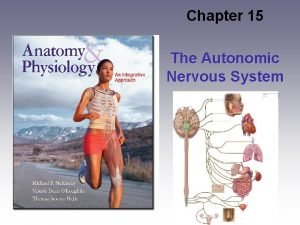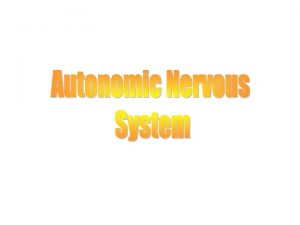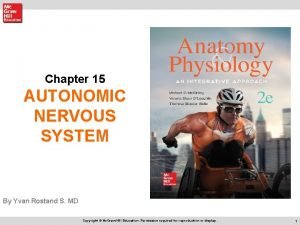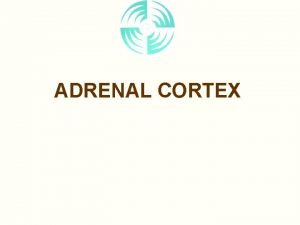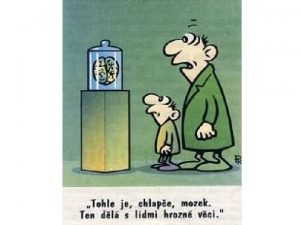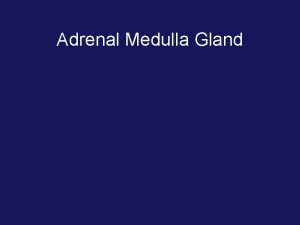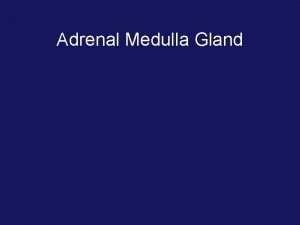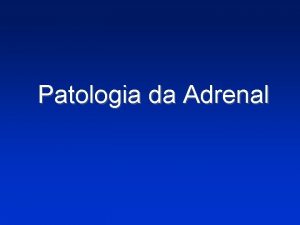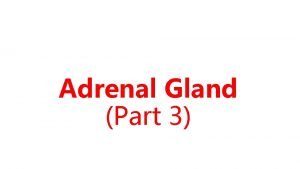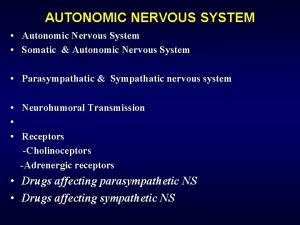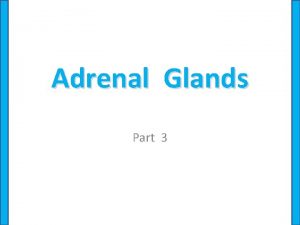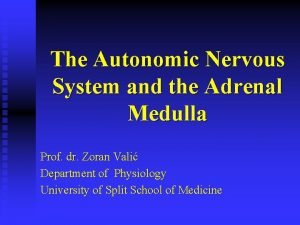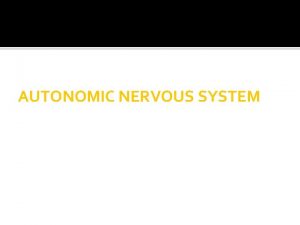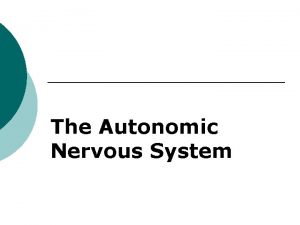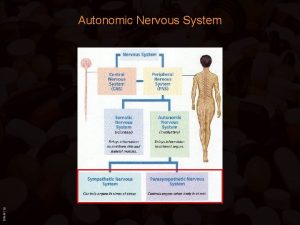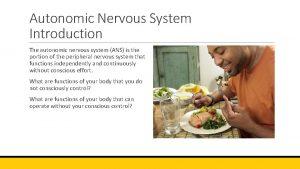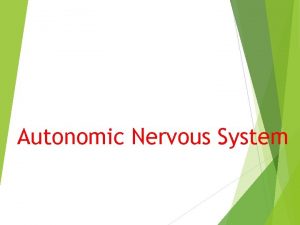The Autonomic Nervous System The Adrenal Medulla Organization




















- Slides: 20

The Autonomic Nervous System; The Adrenal Medulla

Organization of the Autonomic Nervous System • motor system for visceral organs, blood vessels and secretory glands • cell body of preganglionic axon located in brain stem or spinal cord • axon of this visceral motor neuron is thinly myelinated and projects to an autonomic ganglia • cell body of the postganglionic neuron located within the autonomic ganglia, unmyelinated axon projects to visceral effector cell

Organization of the Autonomic Nervous System • Sympathetic ganglia are located close to the spinal cord. • Parasympathetic ganglia are located close to the effector tissues. • Sympathetic pathways have short preganglionic fibers and long postganglionic fibers. • Parasympathetic pathways have long preganglionic and short postganglionic fibers.

Sympathetic Nervous System

Physiologic Anatomy of the sympathetic Nervous System visceral motor neuron located in the intermediolateral horn of the spinal cord from T-1 to L-2. Axons can take 1 of 3 paths 1. enter the sympathetic chain via the white ramus and terminate there 2. enter the sympathetic chain via the white ramus and ascend or descend a few segments before terminating 3. enter via the white ramus and exit via a splanchnic nerve and terminate in a prevertebral ganglia

Physiologic Anatomy of the Parasympathetic Nervous System • Visceral motor neurons are located in discrete brain stem nuclei and in sacral segments 2 -4. • Parasympathetic nerves originate from cranial nerves III, VII, IX, and X and the sacral spinal cord. – occulomotor nerve - fibers to the pupillary sphincters and ciliary muscle – facial nerve - fibers to nasal, lacrimal and submandibular gland – glossopharyngeal nerve - fibers to parotid gland – vagus nerve - motor inputs to visceral organs – sacral segments - fibers to descending colon, rectum, bladder and genitalia

Parasympathetic Nervous System

Characteristics of Sympathetic and Parasympathetic Function • sympathetic nerves release norepinephrine at their nerve endings – these nerves are call adrenergic nerves • parasympathetic nerves release acetylcholine at their nerve endings – these nerves are called cholinergic nerves • almost all postganglionic sympathetic nerves release norepinephrine – except for sweat glands, piloerector muscles and select blood vessels

Characteristics of Sympathetic and Parasympathetic Function • All postganglionic parasympathetic nerves release acetylcholine. • All preganglionic sympathetic and parasympathetic nerves release acetylcholine. • Norepinephrine and epinephrine are synthesized from the amino acid tyrosine. – tyrosine epi DOPA dopamine norepi • Acetylcholine is a combination of acetyl Co. A and choline.

Neurotransmitters • Sympathetic nerves release norepinephrine. – Norepinephrine stimulates alpha and beta adrenergic receptors. – Alpha receptors are located on blood vessels where they cause vasoconstriction. – Beta receptors are further divided into beta 1 and beta 2. • activation of beta 1 - causes an increase in heart rate and contractility • activation of beta 2 - causes bronchial dilation, dilation of blood vessels in skeletal muscles, calorigenesis, and glycogenolysis

Neurotransmitters • Parasympathetic nerves release acetylcholine. – Acetylcholine excites two types of receptors nicotinic and muscarinic. – Nicotinic receptors are found in synapses between the pre- and post- ganglionic neurons. – Muscarinic receptors are found on all effector cells stimulated by postganglionic parasympathetic fibers.

Receptors of the Autonomic Nervous System adrenergic receptors sympathetic preganglionic neuron postganglionic neuron parasympathetic nicotinic receptors muscarinic receptors

Effect of the Autonomic Nervous System on the Organs • eye – sympathetic --pupillary dilation – parasympathetic--pupillary constriction and accommodation (focusing) of the lens • glands of the body – parasympathetic stimulate the nasal, lacrimal, salivary, and G. I. glands – sympathetic stimulates the sweat glands

Effect of the Autonomic Nervous System on the Organs • G. I. tract – parasympathetic stimulates overall activity including G. I. smooth muscle – sympathetic has very little effect • heart – sympathetic increases the rate and contractility – parasympathetic decreases heart rate • blood vessels – sympathetic causes vasoconstriction – parasympathetic causes some vasodilation

Function of the Adrenal Medulla • large sympathetic ganglion • when stimulated releases epinephrine (80%) and norepinephrine (20%) into the blood • causes prolonged activity of the substances – stimulation of cardiovascular function and metabolic rate • helps the body deal with stress

Sympathetic and Parasympathetic “Tone” • the basal rate of activity of each system • this background activity allows for an increase or decrease in activity by a single system – sympathetic tone normally causes about a 50 % vasoconstriction » increasing or decreasing “tone” can change vessel diameter – parasympathetic tone provides background G. I. activity

Stress Response • mass sympathetic discharge – increase in arterial pressure, heart rate and contractility, blood flow to muscles, blood glucose, metabolic rate, muscle strength, mental activity, blood coagulation • prepares the body for vigorous activity need to deal with a life-threatening situation

Pharmacology of the Sympathetic Nervous System • adrenergic or sympathomimetic drugs act like norepi and epi • these drugs have an effect which is much more prolonged than that of either norepi or epi – phenylephrine stimulates alpha receptors – isoproterenol stimulates both beta 1 and beta 2 receptors – albuterol stimulates only beta 2 receptors • some drugs act indirectly by increasing the release of norepi from its storage terminals – ephedrine, tyramine, and amphetamine

Pharmacology of the Sympathetic Nervous System • drugs that block the effect of norepi and epi • synthesis and storage – reserpine • release from the nerve terminal – guanethidine • alpha blockers – phentolamine and phenoxybenzamine • beta blockers – beta 1 and 2 - propranolol, beta 1 - metoprolol • ganglionic blockers – hexamethonium

Pharmacology of the Parasympathetic Nervous System • parasympathomimetic drugs – nicotine • activates nicotinic receptors – pilocarpine and methacholine • activates muscarinic receptors, cause profuse sweating • cholinesterase inhibitors – neostigmine, pyridostigmine, and ambenonium • potentiates the effect of acetylcholine • antimuscarinic drugs – atropine and scopolamine • blocks the effect of acetylcholine on effector cells
 Parasympathetic nervous system def
Parasympathetic nervous system def Autonomic nervous system skeletal muscle
Autonomic nervous system skeletal muscle Autonomic nervous system consists of
Autonomic nervous system consists of Ans
Ans Ans
Ans Autonomic nervous system
Autonomic nervous system The autonomic nervous system controls
The autonomic nervous system controls Autonomic nervous system visceral
Autonomic nervous system visceral Autonomic nervous system
Autonomic nervous system Nervous system main division
Nervous system main division Thyroid
Thyroid Adrenal medulla cortex
Adrenal medulla cortex Adrenal cortex and medulla
Adrenal cortex and medulla Ncl. gracilis
Ncl. gracilis Fundamentals of the nervous system and nervous tissue
Fundamentals of the nervous system and nervous tissue Nervous
Nervous Fundamentals of the nervous system and nervous tissue
Fundamentals of the nervous system and nervous tissue Autonomic nerveous system
Autonomic nerveous system Nervous system and digestive system
Nervous system and digestive system Endocrine system and nervous system
Endocrine system and nervous system Mechanism of hormone action
Mechanism of hormone action





